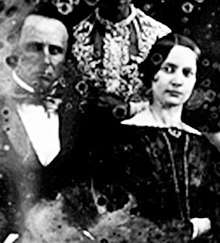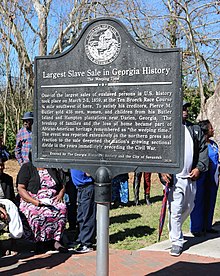The Great Slave Auction
The Great Slave Auction (also called The Weeping Time)[1] was a March 2 and 3, 1859 sale of enslaved Africans held at Ten Broeck Race Course, near Savannah, Georgia. Slaveholder and absentee plantation owner Pierce Mease Butler authorized the sale of approximately 436 men, women, children, and infants to be sold over the course of two days. The sale's proceeds went to satisfy Butler's significant debts, much of it from gambling. The auction is regarded as the largest single sale of enslaved people in U.S. history.

Pierce Mease Butler
The Butlers of South Carolina and Philadelphia were owners of slave plantations located on Butler Island (Butler Island Plantation) and St. Simons Island, just south of Darien, Georgia. The patriarch of the family, Major Pierce Butler, owned hundreds of slaves who labored over rice and cotton crops, thus amassing him the family's wealth. Butler was one of the wealthiest and most powerful slave owners in the United States. Upon his death, his biggest dilemma was which heir to leave his wealth. Estranged from his son, Major Butler left his estate to his two grandsons, Pierce Mease Butler and John A. Mease Butler.[2]
Pierce Mease Butler was devoid of business sense and his grandfather would not have approved of his personal habits. He frequently engaged in risky business speculations, which resulted in financial loss in the Crash of 1857, and his elaborate spending.[3] However, it would be his incorrigible gambling that landed him in the most trouble. Butler had accrued a considerable amount of gambling debt over the years. To satisfy his financial obligations, the management of Butler's estate was transferred to trustees. At first, the trustees sold Butler's Philadelphia mansion for $30,000 as well as other properties but this was not enough to satisfy creditors. The only commodities of value that remained were the slaves he owned on his Georgia plantations.[4]
The sale

Savannah was the perfect location for the auction due to its proximity to the Butler estate, and due to it being a large center for slave trade.[5] Pierce Butler had the impending sale advertised in The Savannah Republican and The Savannah Daily Morning News by Joseph Bryan, a slave dealer in Savannah.[1] The advertisements ran daily, except on Sundays, up until the last day of the sale. The text of some of the ads was, "For Sale, Long Cotton and Rice Negros! A gang of 440, Accustomed to the culture of Rice and Provisions, among them are a no of good mechanics and house servants, will be sold on 2nd and 3rd day of March at Savannah by J Bryan."[6] It was advertised and announced from the beginning that there would be no division of families.[7] The slaves were brought to the race track 4 days before the auction started; allowing buyers and inspectors to take a look at them. [8] On the first sale day, there were about 200 buyers present. Fierce rains kept many of the potential buyers away, and the auction began two hours late.[7] During the day of the sale, Joseph Bryan was in charge of feeding the slaves, and keeping them in "good" condition. The slaves were kept in the horse barn stalls.[9] All family members were put into the same stall. In the stalls they had nothing but the hardwood floors to sit and eat on. The slaves were given small portions of rice and beans, and sometimes cornbread, to eat over the two days.[10] Skin color often played a role in the price a slave would sell for. In this sale it was not a factor, since all of these slaves were the color of their African ancestors.[11] The slaves were skilled in their crafts, e.g. shoe making, cooperage, blacksmithing, carpentry. Some of the slaves had been taught to use machinery.[10] The skilled slaves were sold for more, and were sought by the buyers during the auction.[12]
The slaves

The slaves were brought to Savannah by steamboat and train, and were housed in the stables at the racecourse.[1] They huddled together eating and sleeping on the floor. Beginning from February 26 through March 1, the slaves were inspected by prospective buyers.[1] Anxious buyers from Virginia, North and South Carolina, Georgia, Alabama, and Louisiana descended upon Savannah in hopes of getting good deals. It was known that the Butler plantations had slaves who were skilled tradesmen, e.g. shoe making, cooperage, blacksmithing, carpentry, machine operators. The buyers poked, pinched, and fondled the slaves. They also opened their mouths inspecting their teeth. Slaves were also examined for "ruptures" or defects on their bodies that might affect their productivity.[7]
Four hundred and thirty-six persons were advertised in the sale catalogue, but only four hundred and twenty-nine were sold. Those not sold were either ill or disabled. The majority of those sold were rice and cotton fieldworkers; others were skilled coopers, carpenters, shoemakers, blacksmiths, and cooks. The two-day sale netted $303,850. The highest bid for a family, a mother and her five grown children, was for $6,180. The highest price for an individual was $1,750 whereas the lowest price was $250[13]
The aftermath
Mortimer Thomson, a popular journalist during the time who wrote under the pseudonym "Q. K. Philander Doesticks" memorialized the event.[3] Initially, Thomson traveled to Savannah infiltrating the buyers by pretending to be interested in purchasing slaves. After the sale, he wrote a long and scathing article describing the auction in the New York Tribune titled, "What Became of the Slaves on a Georgia Plantation."[4]
Tom Pate, a Vicksburg trader, bought at the sale a man, his wife, and his two sisters with the guarantee that they were not to be separated in accordance with the terms of the auction. In disregarding the agreement, Pate sold one sister to a Pat Somers, a fellow trader, and the other sister to a private citizen in St. Louis. Somers finding out later of the sales agreement in Savannah about the families not being separated, returned the girl to Pate demanding his money refunded. An argument ensued resulting with Somers being shot and killed. Ten days following Somers's death, his nephew killed Pate, and he himself was killed during the confrontation. The feud continued until every man bearing the name Pate was killed.[14]
After the slaves were freed, some of them returned to Butler Island to work for wages and some bought land in the area.[15]
Historical markers
There are two Georgia historical markers commemorating this historic event. One is at 2053 Augusta Avenue in Savannah, Georgia, erected by the city and the Georgia Historical Society in 2008.[1] The other is at Butler Plantation, erected by the Georgia Historical Society in 2019.[16][17]
See also
Notes
- Kwesi, DeGraft-Hanson (2010-01-01). "Unearthing the Weeping Time: Savannah's Ten Broeck Race Course and 1859 Slave Sale". Southern Spaces. 2010. doi:10.18737/M76K6J. ISSN 1551-2754.
- Berry, Steven W. (3 September 2002). "Butler Family". New Georgia Encyclopedia. University of Georgia Press.
- Monroe, Kristopher (10 July 2014). "The Weeping Time". The Atlantic.
- "The Weeping Time Occurs". The African American Registry.
- Bailey, Anne C. (2017). The Weeping Time: Memory and The Largest Slave Auction In American History. Cambridge University Press. p. 9.
- "Founder". nationaljuneteenth. Retrieved 2019-11-04.
- "Slave Auction, 1850".
- Humanities, National Endowment for the (1859-03-09). "New-York daily tribune. [volume] (New-York [N.Y.]) 1842-1866, March 09, 1859, Image 5". New-York Daily Tribune. ISSN 2158-2661. Retrieved 2019-11-06.
- Hassan, Adeel (2020-02-29). "The Hidden History of Slavery That Surrounds Us". The New York Times. ISSN 0362-4331. Retrieved 2020-03-01.
- Humanities, National Endowment for the (1859-03-09). "New-York daily tribune. [volume] (New-York [N.Y.]) 1842-1866, March 09, 1859, Image 5". New-York Daily Tribune. ISSN 2158-2661. Retrieved 2019-11-06.
- Doesticks, Q. K. Philander; Butler, Pierce (1863). What became of the slaves on a Georgia plantation? : great auction sale of slaves, at Savannah, Georgia, March 2d & 3d, 1859 : a sequel to Mrs. Kemble's journal. Daniel Murray Pamphlet Collection (Library of Congress).
The slaves themselves were but very few that were even a shade removed from the original Congo blackness.
- Bailey, Anne C. (2017). The Weeping Time: Memory And The Largest Slave Auction In American History. Cambridge University Press. p. 64.
- Harris, Leslie M. (2013). Slavery and Freedom in Savannah. Athens: University of Georgia Press.
- Haley, James T. "Afro-American Encyclopaedia; Or, the Thoughts, Doings, and Sayings of the Race". Documenting the American South.
- Ga. Hist. Soc.
- GHS
- Ga. Hist. Soc.
External links
- Largest Slave Sale in Georgia History: The Weeping Time historical marker
| Wikimedia Commons has media related to The Great Slave Auction. |